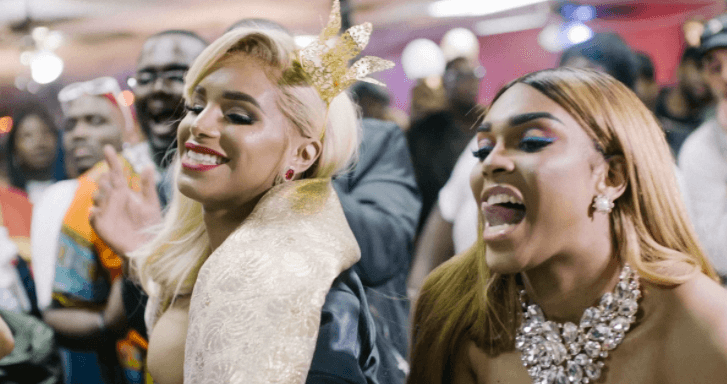History shows that drag begat drag balls or parties where men and women dressed up in drag. The “parade of faeries” from those events begat drag pageants, or formal competitions for drag queen as encapsulated in the 1968 documentaryThe Queen.
As frustration mounted for queens of color who felt that these pageants were routinely rigged against them, they broke off. On their own, they created the ballroom scene where we got the houses of Ninja and LaBeija, among others, and where the art form of voguing was cultivated.
But as the beginning of this week’s episode of My House showed, the evolving didn’t end there. Welcome to the kiki scene.
“There’s so much energy and creativity right now,” Jelani Mizrahi said from the Playhouse Kiki Ball in Brooklyn on the episode. “That’s what I love about the kiki scene.”
Subscribe to get a twice-weekly dose of queer news, updates, and insights from the INTO team.
in Your Inbox
There, like in the ballroom scene, participants join houses (Alex and Tati run the House of Juicy Couture) to face off in a variety of categories. The main difference? Age.
“The kiki scene is a space for youth development,” Gia Marie Love says in Kiki, the 2016 documentary which dives into the subculture. “Everyone is unique; the kiki scene is a place for young people to explore that uniqueness.”
But it’s more than just a place of explorationit’s a place of safety.
“This subset of that ballroom scene, which is called the kiki scene, the youthas low as age 12 and 13, have the same types of balls [as ballroom] as a creative outlet to get away from all the things that put them at risk,” said Twiggy Pucci Garcon, founder of the kiki scene’s opulent House of Pucci, in the documentary. “The homelessness, the disease, the lack of acceptance, all these other things.” And it also serves as a bit of a training ground for the overall larger scene.
“It was started to keep the young LGBTQ off the streets because a lot of them were hanging at the village, or on the Piers selling their bodies,” ballroom’s iconic Stanley Milan tells INTO. “But it also started because they couldn’t get into the balls because of their age. It was supposed to be a safe arena where they could go and have fun and practice there would be no pressure. You could go and walk face and not actually have what ballroom considers to be face but just walk just for the fun of it.”
As such, many of the players overlap in the scenes: Twiggy is the founder of Pucci in the kiki scene but a member of the House of Garcon in ballroom.
On My House, Alex is both a member of the ballroom House of Mugler as well as the founder of Juicy Couture in the kiki scene. “I’ve been a legend in the kiki scene for a long time,” he said in the episode, though he only recently became a ballroom legend.
Elsewhere Tati gives context for walking face as a trans woman. In addition to telling the story of her transition, detailing her mother’s reaction, she speaks to how walking in a category that prizes a perfection of looks scoring on skin clarity, bone structure and confidence makes her feel.
“It’s always been a category I wanted to walk,” Tati admitted on screen. “I feel like within transition you are blossoming within your womanhood and you naturally want to celebrate your beauty and your glamour.”
And though this would only apply to trans people who desire to conform to certain cisgender aesthetics, for them it can prove affirming.
Watch My House on VICELAND on Wednesdays at 10:30pm EST or stream it online.













